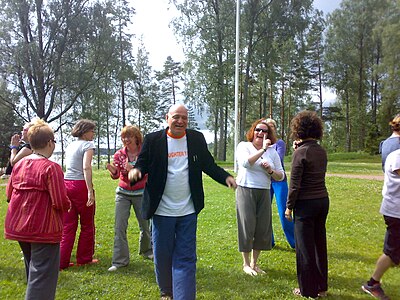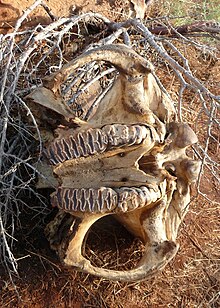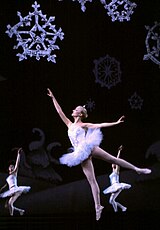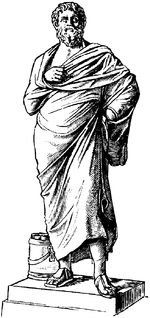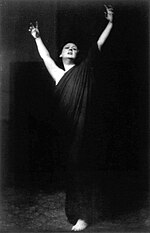Performing arts are art forms in which artists use their voices and/or the movements of their bodies, often in relation to other objects, to convey artistic expression—as opposed to, for example, purely visual arts, in which artists use paint/canvas or various materials to create physical or static art objects. Performing arts include a variety of disciplines but all are intended to be performed in front of a live audience.
Performers[edit]
A performer who excels in acting, singing, and dancing is commonly referred to as a "triple threat".
[1] Well-known examples of historical triple threat artists include Gene Kelly, Fred Astaire, and Judy Garland.
[1]
Performing arts may include
dance,
music,
opera,
theatre and
musical theatre,
magic,
illusion,
mime,
spoken word,
puppetry,
circus arts,
performance art, recitation and public speaking.
There is also a specialized form of
fine art, in which the artists
perform their work live to an audience. This is called
performance art. Most performance art also involves some form of plastic art, perhaps in the creation of
props. Dance was often referred to as a
plastic art during the
Modern dance era.
[citation needed]
Theatre[edit]
Theatre is the branch of performing arts; concerned with
acting out stories in front of an audience, using a combination of speech, gesture, music, dance, sound and spectacle. Any one or more of these elements is performing arts. In addition to the standard narrative dialogue style of plays. Theatre takes such forms as
plays,
musicals,
opera,
ballet,
illusion,
mime,
classical Indian dance,
kabuki,
mummers' plays,
improvisational theatre,
stand-up comedy,
pantomime, and non-conventional or contemporary forms like
postmodern theatre,
postdramatic theatre, or
performance art .
Dance is a powerful impulse, but the art of dance is that impulse channeled by skillful performers into something that becomes intensely expressive and that may delight spectators who feel no wish to dance themselves. These two concepts of the art of dance—dance as a powerful impulse and dance as a skillfully choreographed art practiced largely by a professional few—are the two most important connecting ideas running through any consideration of the subject. In dance, the connection between the two concepts is stronger than in some other arts, and neither can exist without the other.
[2]
Choreography is the art of making dances, and the person who practices this art is called a choreographer.
History[edit]
History of Western performing arts[edit]
However, by the 6th century AD, Western performing arts had been largely ended, as the
Dark Ages began. Between the 9th century and 14th century, performing art in the West was limited to religious historical enactments and
morality plays, organized by the
Church in celebration of holy days and other important events.
Renaissance[edit]
Main article:
Renaissance
In the 15th century performing arts, along with the arts in general, saw a revival as the Renaissance began in
Italy and spread throughout
Europe plays, some of which incorporated dance, which were performed and
Domenico da Piacenza credited with the first use of the term
ballo (in
De Arte Saltandi et Choreas Ducendi) instead of
danza (dance) for his
baletti or
balli. The term eventually became
Ballet. The first Ballet
per se is thought to be
Balthasar de Beaujoyeulx's
Ballet Comique de la Reine (1581).
In 1597, the first
opera,
Dafne was performed and throughout the 17th century, opera would rapidly become the entertainment of choice for the
aristocracy in most of Europe, and eventually for large numbers of people living in cities and towns throughout Europe.
Modern era[edit]
Main article:
Modern world
The introduction of the
proscenium arch in Italy during the 17th century established the traditional theatre form that persists to this day. Meanwhile, in England, the
Puritans forbade acting, bringing a halt to performing arts that lasted until 1660. After that, women began to appear in both
French and English plays. The French introduced a formal dance instruction in the late 17th century.
It is also during this time that the first plays were performed in the
American Colonies.
The 19th century was a period of growth for the performing arts for all social classes, technical advances such as the introduction of
gaslight to theatres,
burlesque, minstrel dancing, and variety theatre. In ballet, women make great progress in the previously male-dominated art.
Modern dance began in the late 19th century and early 20th century in response to the restrictions of traditional ballet.
Konstantin Stanislavski's
"System" revolutionized acting in the early 20th century, and continues to have a major influence on actors of stage and screen to the current day. Both
impressionism and modern realism were introduced to the stage during this period.
The arrival of
Sergei Diaghilev's
Ballets Russes (1909–1929) revolutionized ballet and the performing arts generally throughout the Western world, most importantly through Diaghilev's emphasis on collaboration, which brought choreographers, dancers, set designers/artists, composers and musicians together to revitalize and revolutionize ballet. It is extremely complex.
Rhythm and blues, a cultural phenomenon of black America, became to prominence in the early 20th century; influencing a range of later popular music styles internationally.
Post-War performance[edit]
Post-World War II performing arts were highlighted by the resurgence of both ballet and opera in the Western world.

Modern street theatre performance in La Chaux-de-Fonds
Postmodernism in performing arts dominated the 1960s to large extent.
History of Eastern performing arts[edit]
Middle East[edit]
The earliest recorded theatrical event dates back to 2000 BC with the
passion plays of
Ancient Egypt. This story of the god
Osiris was performed annually at festivals throughout the civilization, marking the known beginning of a long relationship between theatre and religion.
In
Iran there are other forms of theatrical events such as
Naghali (story telling),
ٰRu-Howzi,
Siah-Bazi,
Parde-Khani, 'Mareke giri.
India and Pakistan[edit]
Folk theatre and dramatics can be traced to the religious ritualism of the
Vedic peoples in the
2nd millennium BC. This folk theatre of the misty past was mixed with dance, food, ritualism, plus a depiction of events from daily life. The last element made it the origin of the classical theatre of later times. Many historians, notably D. D. Kosambi, Debiprasad Chattopadhyaya, Adya Rangacharaya, etc. have referred to the prevalence of ritualism amongst
Indo-Aryan tribes in which some members of the tribe acted as if they were wild animals and some others were the hunters. Those who acted as mammals like goats, buffaloes, reindeer, monkeys, etc. were chased by those playing the role of hunters.
Bharata Muni (fl. 5th–2nd century BC) was an ancient Indian writer best known for writing the
Natya Shastra of Bharata, a theoretical treatise on Indian performing arts, including
theatre,
dance,
acting, and
music, which has been compared to
Aristotle's
Poetics. Bharata is often known as the father of Indian theatrical arts. His
Natya Shastra seems to be the first attempt to develop the technique or rather art, of drama in a systematic manner. The Natya Shastra tells us not only what is to be portrayed in a drama, but how the portrayal is to be done. Drama, as Bharata Muni says, is the imitation of men and their doings (
loka-vritti). As men and their doings have to be respected on the stage, so drama in Sanskrit is also known by the term
roopaka, which means portrayal.
The
Ramayana and
Mahabharata can be considered the first recognized plays that originated in India. These epics provided the inspiration to the earliest Indian dramatists and they do it even today. Indian dramatists such as
Bhasa in the 2nd century BC wrote plays that were heavily inspired by the
Ramayana and
Mahabharata.
Kālidāsa in the 1st century BC, is arguably considered to be ancient
India's greatest dramatist. Three famous romantic plays written by Kālidāsa are the
Mālavikāgnimitram (
Mālavikā and Agnimitra),
Vikramuurvashiiya (
Pertaining to Vikrama and Urvashi), and
Abhijñānaśākuntala (
The Recognition of Shakuntala). The last was inspired by a story in the
Mahabharata and is the most famous. It was the first to be translated into
English and
German. In comparison to Bhasa, who drew heavily from the epics, Kālidāsa can be considered an original
playwright.
The next great Indian dramatist was
Bhavabhuti (c. 7th century). He is said to have written the following three plays:
Malati-Madhava,
Mahaviracharita and
Uttar Ramacharita. Among these three, the last two cover between them, the entire epic of
Ramayana. The powerful Indian emperor
Harsha (606–648) is credited with having written three plays: the comedy
Ratnavali,
Priyadarsika, and the
Buddhist drama
Nagananda. Many other dramatists followed during the
Middle Ages.
There are references to theatrical entertainments in China as early as 1500 BC during the
Shang Dynasty; they often involved music, clowning and acrobatic displays.
The Tang dynasty is sometimes known as "The Age of 1000 Entertainments". During this era,
Emperor Xuanzong formed an acting school known as the Children of the
Pear Garden to produce a form of drama that was primarily musical.
During the Han Dynasty,
shadow puppetry first emerged as a recognized form of theatre in China. There were two distinct forms of shadow puppetry, Cantonese southern and Pekingese northern. The two styles were differentiated by the method of making the puppets and the positioning of the rods on the puppets, as opposed to the type of play performed by the puppets. Both styles generally performed plays depicting great adventure and fantasy, rarely was this very stylized form of theatre used for political propaganda. Cantonese shadow puppets were the larger of the two. They were built using thick leather that created more substantial shadows. Symbolic color was also very prevalent; a black face represented honesty, a red one bravery. The rods used to control Cantonese puppets were attached perpendicular to the puppets' heads. Thus, they were not seen by the audience when the shadow was created. Pekingese puppets were more delicate and smaller. They were created out of thin, translucent leather usually taken from the belly of a donkey. They were painted with vibrant paints, thus they cast a very colorful shadow. The thin rods that controlled their movements were attached to a leather collar at the neck of the puppet. The rods ran parallel to the bodies of the puppet then turned at a ninety degree angle to connect to the neck. While these rods were visible when the shadow was cast, they laid outside the shadow of the puppet; thus they did not interfere with the appearance of the figure. The rods attached at the necks to facilitate the use of multiple heads with one body. When the heads were not being used, they were stored in a muslin book or fabric lined box. The heads were always removed at night. This was in keeping with the old superstition that if left intact, the puppets would come to life at night. Some puppeteers went so far as to store the heads in one book and the bodies in another, to further reduce the possibility of reanimating puppets. Shadow puppetry is said to have reached its highest point of artistic development in the 11th century before becoming a tool of the government.
In the
Song dynasty, there were many popular plays involving
acrobatics and
music. These developed in the
Yuan Dynastyinto a more sophisticated form with a four- or five-act structure. Yuan drama spread across China and diversified into numerous regional forms, the best known of which is Beijing Opera, which is still popular today.
Thailand[edit]
In
Thailand, it has been a tradition from the Middle Ages to stage plays based on plots drawn from Indian epics. In particular, the theatrical version of Thailand's national epic
Ramakien, a version of the Indian
Ramayana, remains popular in Thailand even today.
Cambodia[edit]
Main articles:
Noh,
Bunraku,
Kabuki and
Butoh
During the 14th century, there were small companies of actors in Japan who performed short, sometimes vulgar comedies. A director of one of these companies, Kan'ami (1333–1384), had a son,
Zeami Motokiyo (1363–1443) who was considered one of the finest child actors in Japan. When Kan'ami's company performed for
Ashikaga Yoshimitsu (1358–1408), the Shogun of Japan, he implored Zeami to have a court education for his arts. After Zeami succeeded his father, he continued to perform and adapt his style into what is today
Noh. A mixture of
pantomime and vocal acrobatics, this style has fascinated the Japanese for hundreds of years.
Japan, after a long period of civil wars and political disarray, was unified and at peace primarily due to shogun Tokugawa Ieyasu (1600–1668). However, alarmed at increasing Christian growth, he cut off contact from Japan to Europe and China and outlawed Christianity. When peace did come, a flourish of cultural influence and growing merchant class demanded its own entertainment. The first form of theatre to flourish was Ningyō jōruri (commonly referred to as
Bunraku). The founder of and main contributor to Ningyō jōruri,
Chikamatsu Monzaemon (1653–1725), turned his form of theatre into a true art form. Ningyō jōruri is a highly stylized form of theatre using puppets, today about 1/3d the size of a human. The men who control the puppets train their entire lives to become master puppeteers, when they can then operate the puppet's head and right arm and choose to show their faces during the performance. The other puppeteers, controlling the less important limbs of the puppet, cover themselves and their faces in a black suit, to imply their invisibility. The dialogue is handled by a single person, who uses varied tones of voice and speaking manners to simulate different characters. Chikamatsu wrote thousands of plays during his lifetime, most of which are still used today.
Kabuki began shortly after Bunraku, legend has it by an actress named Okuni, who lived around the end of the 16th century. Most of Kabuki's material came from Nõ and Bunraku, and its erratic dance-type movements are also an effect of Bunraku. However, Kabuki is less formal and more distant than Nõ, yet very popular among the Japanese public. Actors are trained in many varied things including dancing, singing, pantomime, and even acrobatics. Kabuki was first performed by young girls, then by young boys, and by the end of the 16th century, Kabuki companies consisted of all men. The men who portrayed women on stage were specifically trained to elicit the essence of a woman in their subtle movements and gestures.
